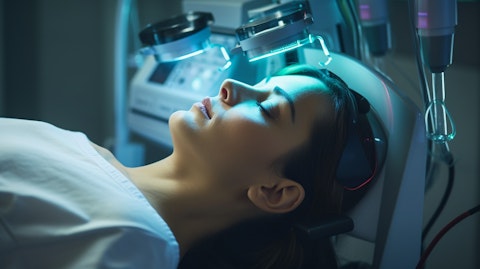We recently compiled a list of the 10 Best Cosmetic Surgery and Aesthetics Stocks To Buy. In this article, we are going to take a look at where Cutera, Inc. (NASDAQ:CUTR) stands against the other cosmetic surgery and aesthetics stocks.
While imperfections are inherent to being human, aesthetic (or cosmetic) plastic surgery is a viable alternative if self-consciousness and unhappiness over your appearance are causing you distress.
Estimated at $57.67 billion in 2023, the global cosmetic surgery market is expected to grow at a CAGR of 4.0% from $59.77 billion in 2024 to $81.66 billion by 2032, as per Fortune Business Insights. Regionally, North America dominated the market in 2023, with a market value of $18.10 billion.
Per the aforementioned research, the market is growing mainly because cosmetic procedures are becoming increasingly popular among people in general as a means of improving their visual appeal. Following the pandemic, when most individuals were attending virtual meetings and interacting on social media, there was a notable spike in cosmetic surgery. According to a 2023 study, there was an almost 30% rise in cosmetic procedures in 2021, compared to 2019, and a nearly 50% increase in 2020.
According to the annual Global Survey on Aesthetic/Cosmetic Procedures, in 2023, plastic surgeons performed over 15.8 million surgical procedures, up 5.5% from the previous year. There has been a 40% rise overall over the past four years. As per the survey, liposuction was the most prevalent surgical procedure in 2023 and 2022, with over 2.2 million carried out, followed by breast augmentation, eyelid surgery, abdominoplasty, and rhinoplasty. Botulinum toxin, hyaluronic acid, hair removal, non-surgical skin tightening, and non-surgical fat reduction were the most popular non-surgical procedures. All face and head operations rose by 19.6% over the previous year, totaling more than 6.5 million procedures.
According to Dan Yamini, M.D., a board-certified plastic surgeon at Visthetic Surgery Institute & Med Spa, the growing trend of minimally invasive procedures like injectables (such as fillers and neurotoxins) that enable people to address specific concerns and achieve subtle improvements without surgery is indicative of the desire for natural looks.
Top plastic surgeons debated and discussed the newest ideas and innovations in plastic surgery at this year’s American Society for Aesthetic Plastic Surgery (The Aesthetic Society) conference in Vancouver. Preservation rhinoplasty, which reshapes the nose while preserving its natural structure and provides a more nuanced approach than standard procedures, was a hot topic. While plastic surgeon Adam Rubinstein, MD, of Miami, believes it’s just a marketing word, Austin, Texas’s Adam Weinfeld, MD, appreciates its subtle approach.
Secondly, the buzz is also about GLP-1’s role in plastic surgery. GLP-1 medications, which were once developed to treat diabetes, are now used to reduce weight but a side effect of them is the sagging of the skin. Johnny Franco, MD, a plastic surgeon in Austin, Texas, states that after using GLP-1s to lose a large amount of weight, patients are now looking for remedies for sagging skin. They revealed that to address this, they provide surgical alternatives as well as skin-tightening therapies such as BodyTite and Renuvion. Conversely, the Delray Beach, FL, plastic surgeon Drew Schnitt, MD, warns against their long-term consequences. Extended stomach tucks are advised by New York plastic surgeon Mokhtar Asaadi, MD to tighten skin and muscles after weight loss.
GLP-1 drugs are all the rage in 2024 and the global weight loss drugs market is expected to reach $130 billion by 2030, as per estimates by JP Morgan Research. We covered this theme in our article about the 10 Best GLP-1 and Weight Loss Stocks to Buy Now. Here’s an excerpt from the article:
“Over the past ten years, the usage of GLP-1 drugs, such as semaglutide, for weight loss has doubled, but among those with type 2 diabetes, its use has decreased by almost 10%, according to research published on Monday in the Annals of Internal Medicine. The prolonged medication scarcity that followed, the researchers caution, may restrict the medications’ accessibility to those with diabetes. Dr. Yee Hui Yeo, a clinical fellow in the Karsh Division of Gastroenterology and Hepatology at Cedars-Sina, highlighted that as demand for obesity medications rises, it is critical to guarantee that diabetic patients have access to GLP-1 medicines.
The FDA claims that the shortages are the result of rising demand. Not only do the shortages impact the United States: The European Medicines Agency cautioned that the GLP-1 drug shortage is a “major public health concern” that is unlikely to be remedied in 2024. People with diabetes have struggled to obtain their prescriptions due to shortages, with some limiting their drugs to manage, according to NPR.”
Our Methodology
We sifted through online rankings and holdings of ETFs to form an initial list of 15 best cosmetic surgery and aesthetics stocks. Then we selected the 10 stocks that were the most popular among institutional investors. The stocks are ranked in ascending order of the number of hedge funds that have stakes in them.
Why are we interested in the stocks that hedge funds pile into? The reason is simple: our research has shown that we can outperform the market by imitating the top stock picks of the best hedge funds. Our quarterly newsletter’s strategy selects 14 small-cap and large-cap stocks every quarter and has returned 275% since May 2014, beating its benchmark by 150 percentage points. (see more details here).

A medical technician examining a device used in laser and energy-based aesthetics systems.
Cutera, Inc. (NASDAQ:CUTR)
Number of Hedge Fund Investors: 11
One of the leading global suppliers of dermatological and cosmetic products to medical professionals is Cutera, Inc. (NASDAQ:CUTR). The company creates, manufactures, and markets energy-based product platforms intended primarily for medical professionals. It also distributes skincare products made by third parties. Hence, it holds a strong position in the cosmetic surgery and aesthetics markets.
Cutera’s stock price has fallen more than 98% till date from its 2020 high of $72.31, mostly as a result of significant management changes and a lack of strategy from the company. Cutera, Inc. (NASDAQ:CUTR) then announced the appointment of Jeryl ‘Jeri’ Hilleman to its Board of Directors, effective July 12, 2024. The company highlighted her extensive governance roles and more than 30 years of experience in the healthcare industry. By utilizing her financial leadership and planning skills, Cutera will support the company’s expansion and innovation, especially with AviClear.
Revenue of $38.8 million was announced for the first quarter of 2024 by Cutera, Inc. (Nasdaq: CUTR), and was above analysts’ projections of $37.17 million. Nonetheless, it was a 29% drop from the same quarter the year before.
The successful introduction of xeo+ and robust sequential growth in AviClear revenue was noted by the company in Q1. The gross profit for the quarter was $12.4 million, down 42.58% from the same period the previous year. Operating costs were $31.9 million, down more than 13%, and cash equivalents were $105.4 million, down 60.60% from the same quarter the previous year. Cutera restated its $160-170 million sales forecast for 2024.
Despite cutting the price target from $10.00 to $6.00 in March, Stifel nevertheless retains a Buy rating on Cutera because of the company’s potential for a sizable market uptake of the AviClear device in 2024. Higher profit margins and lower cash burn are essential components of a successful turnaround.
Overall, analysts are bullish on this stock and have given CUTR a Buy rating. The average price target for Cutera, Inc. (NASDAQ:CUTR) is $7.67, which presents a 404.61% upside potential from the current price of $1.52. According to Insider Monkey’s Q1 2024 database, 11 hedge funds held stakes in the company. Glenn Russell Dubin’s Highbridge Capital Management held the largest stake in the company, with 32,685,000 shares worth $13.36 million.
Overall CUTR ranks 8th on our list of the best cosmetic surgery and aesthetics stocks to buy. You can visit 10 Best Cosmetic Surgery and Aesthetics Stocks To Buy to see the other cosmetic surgery and aesthetic stocks that are on hedge funds’ radar. While we acknowledge the potential of CUTR as an investment, our conviction lies in the belief that AI stocks hold greater promise for delivering higher returns, and doing so within a shorter time frame. If you are looking for an AI stock that is more promising than CUTR but that trades at less than 5 times its earnings, check out our report about the cheapest AI stock.
READ NEXT: Analyst Sees a New $25 Billion “Opportunity” for NVIDIA and Jim Cramer is Recommending These 10 Stocks in June.
Disclosure: None. This article is originally published at Insider Monkey.





